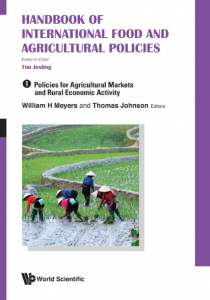Book – Handbook of International Food and Agricultural Policies
Meyers, W., & Johnson, T. G. (Eds.). (2018). Handbook of International Food and Agricultural Policies (Vol. 1). World Scientific.
 Volume I covers farm and rural development policies of developed and developing countries. The volume contains 20 country chapters together with an introduction and a concluding synthesis of lessons to be drawn from the experiences of the individual countries. The countries include major agricultural countries — the US, the EU, Japan, Australia and Canada — as well as globally important developing countries — Brazil, India, Indonesia, Chile, China and South Africa. In addition, chapters on Pakistan, Kenya, Ghana, Vietnam and Kazakhstan introduce readers to important but understudied countries.
Volume I covers farm and rural development policies of developed and developing countries. The volume contains 20 country chapters together with an introduction and a concluding synthesis of lessons to be drawn from the experiences of the individual countries. The countries include major agricultural countries — the US, the EU, Japan, Australia and Canada — as well as globally important developing countries — Brazil, India, Indonesia, Chile, China and South Africa. In addition, chapters on Pakistan, Kenya, Ghana, Vietnam and Kazakhstan introduce readers to important but understudied countries.
The volume describes the history and rationale for policy support of farm and rural residents in the countries included. Meyers and Johnson in their introduction assert that the history of a country cannot be fully understood without an appreciation for the role that agriculture has played in economic, social and cultural evolution. And this evolution cannot be understood without an appreciation for the role that public policy has played in the changes in the agricultural sector and in the outcomes for rural families and communities. This volume provides a basis for understanding the role of history, culture, politics, and technology, as well as economics in the evolution of agricultural and rural policy.
Like most public policy, agricultural and rural policy is shaped by the processes of collective choice within each country’s distinctive institutional and socioeconomic context. These contexts are dynamic and changing over time. Some generalizations are however possible, as explored in the volume. The increasing global organization of the food and farm sector has led to a rising interest by domestic policy-makers in international forces, and a corresponding international interest in domestic agricultural policies. Agricultural policy has consequently evolved over time to focus more on issues of the international competitiveness of agriculture and agribusiness. The tension between traditional objectives of protecting farmers from the cold winds of competition and the more modern view of the sector as a contributor to economic development in a world of relatively open markets is being felt in each of the countries studied in the volume.
In developed countries, agricultural and rural policy has tended to become more distinct over time as the rural populations have become less linked to agriculture. The focus of rural policy has returned to issues of public service provision, social safety nets and economic development. This development is captured in detail in the separate chapters on farm policy and rural development in the US, the EU and Canada. In most developing countries, the two aspects of farm and rural policy are still entwined and provide the context for much of the choices that governments in these countries have to make.
The concluding chapter of the volume places the individual country experiences in the context of broad trends in technology, trade and environmental policy
